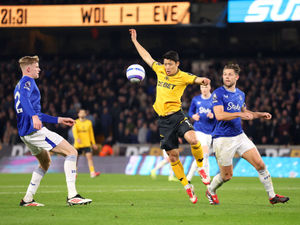Wolves fan David shining a light on forgotten moments
From the formation of the football league to the start of the Second World War - a new book is shedding light on a lesser-known chapter of Wolves' colourful history.
Written by lifelong fan David Dungar, Cometh Light showcases Wolverhampton's footballing and industrial heritage between 1888 and 1939, which saw the club involved in six cup finals.
It's been a labour of love for the 65-year-old author who painstakingly combed the archives and official board meeting minutes to solve some mysteries from the time period.
With the help of historical maps and photographs, he also researched the industries in the town in the same period when Wolverhampton went from making horse-drawn transport to the world's first 200mph car at Sunbeam.
"This era has been scantily covered before in other Wolves histories and so I wanted to share what I had found with fellow fans.
"I don’t know of another football club history that has looked in parallel at the football club on the field and where the local fans would have been working when not standing on the shale terraces supporting their team. I didn't want this piece of Wolverhampton's history to disappear," says Mr Dungar who lives in Pattingham.
A keen collector of Wolves memorabilia, his journey was partly inspired by a postcard celebrating the club's 1908 FA Cup final win which he bought for 'next to nothing' from eBay.
It had both Wolverhampton and Newcastle postmarks and been sent less than two weeks after Wolves' 3-1 victory over Newcastle United.
The card was produced by Paulton of Wolverhampton which shows a wolf in a Wolves kit caricature pulling down a castle in the sky.
It carried the message 'are we down arted no' which was a reference to the Newcastle MP telling his fellow-countrymen that they wouldn't be 'down-hearted' following their defeat.
"I was convinced it had been sent by a Wolves player because of the postmark. I was able to compare handwriting and confirm it had been sent by the Wolves captain Billy Wooldridge to Billy Appleyard, the Newcastle striker he had marked out of the game, as a bit of banter.
"It could be one of the earliest and oldest surviving examples of FA Cup banter between two players. This is common place now and I thought if I don't share this with everybody it will disappear," explains Mr Dungar who works as a forensic quantity surveyor.
Three years ago he decided to carry out more research on the old gold club's early years with the aim of pulling everything together into a book.
Starting with the club becoming one of the 12 founding members of the football league in 1888, it runs through to the start of the Second World War.
Wolves footballing exploits are examined on a season-by-season basis in the period which also saw them almost pull off the first league and cup double of the 20th century.
While trawling through the archives and records, he discovered a 'forgotten' stand that wasn't recorded in recent records. It stood on Waterloo Road in 1909 and was designed by architect Marcus Browne.
"It's not mentioned in other Wolves histories but I found a photograph taken at Molineux and you can just see it," explains Mr Dungar.
His 340-page book also reveals for the first time in nearly 100 years the wording on the great flag that flew from the North Bank in 1925 at the opening of the new Waterloo Stand.
"In photographs it's just a smudge so you can't read what it says. But I found it mentioned in the minutes and it's celebrating the cup victories of 1892/93 and 1907/08," he explains.
The board meeting minutes proved fascinating reading for Mr Dungar.
"The were all genuine local businessmen who had their heart in the club. They would take the flack when Wolves weren't doing well and would put their hand in their pocket when the club needed money short-term. They always went to matches," he says.
Mr Dungar says he was also keen to look at the social history in the town and enjoyed looking at old photographs from the time period.
"I ploughed through endless press cuttings of the era to provide examples of how the game was played in this period. Pictures of the time show women attended in numbers and fans travelled by train in numbers to support their team, despite the often poor and erratic away form.
"The book covers a period where we have been led to believe crowd behaviour was better and the players behaved in a more sporting manner. The book dispels these myths.
"Wolverhampton Wanderers were subjected to two ground closures: one in 1895 and one in 1919 for crowd misbehaviour," he explains.
The book also pays homage to the town's industrial heritage including the 1902 Wolverhampton Art & Industrial Exhibition held in West Park.
His research has also enabled him to put numerous names to previously ‘unknown’ players in Wolves team line-up photos and dated the seasons of many that were also previously unknown.
"My research also revealed that the background picture on the Wolves Club Centenary Book in 1977 was of a Wolves reserve team. It's quite surprising because of all of the sides they could have chosen over that time," says Mr Dungar.
"I hope I have put some colour into this extraordinary period in Wolverhampton's history, both on and off the pitch and shone a torch on some previous unpublished Wolves material," he adds.
*Cometh Light is currently available from Waterstones in Wolverhampton and Amazon and from March 1 will be on sale at the Wolves club shop.





